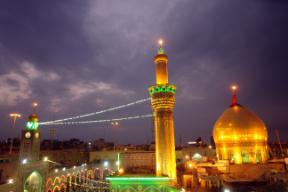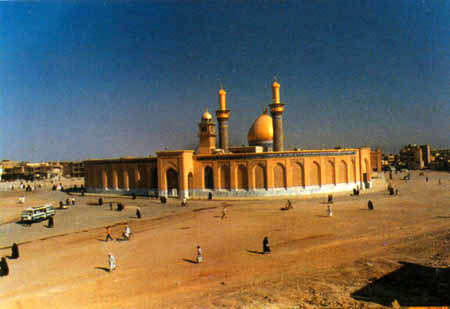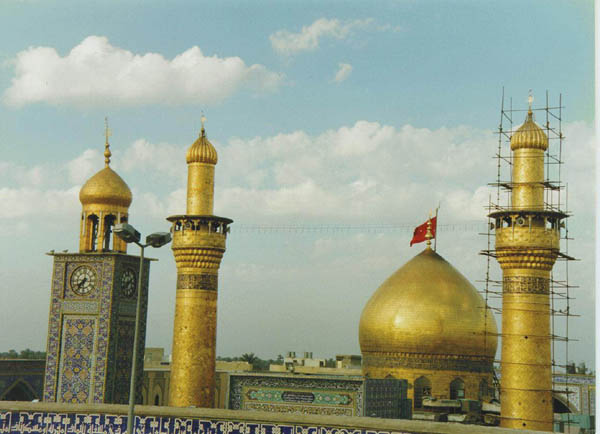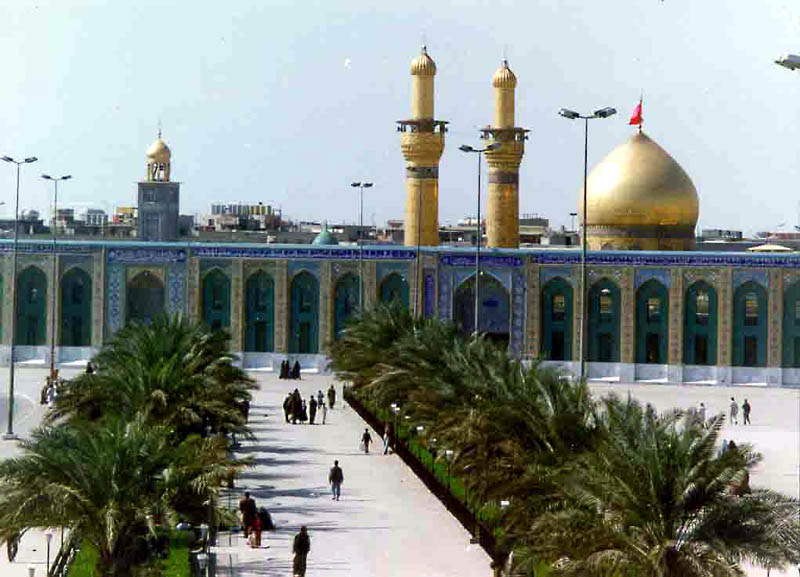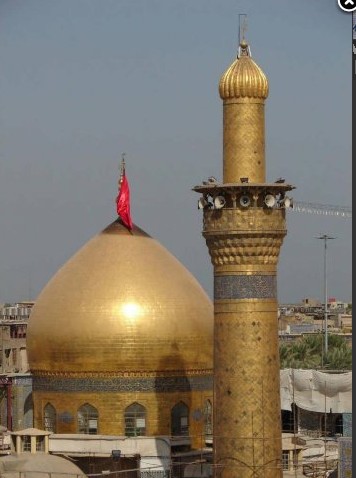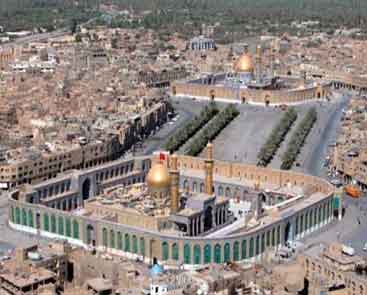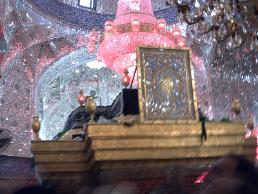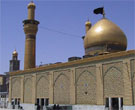Holy Imam Hussain ibn Ali ibn Abu Talib (8 January 626 CE - 10 October 680 CE) (3rd sha'aban 4 AH - 10th Muharram 61 AH) was the son of Holy Imam Ali ibn abi Talib (a.s) (final Rashidun Caliph and first Shia Imam) and Bibi Fatimah Zahra (daughter of the Holy Prophet Muhammaed (pbuh) and the younger brother of Holy Imam Hasan ibn Ali (a.s). Holy Imam Hussin (a.s) is an important figure in Islam as he is a member of the Ahl-al-Bayt (the household of Holy Prophet Muhammad) (pbuh) and Ahl-al-Kisa, as well as being an Imam.
Holy Imam Hussain (a.s) is highly regarded by Shia as a martyr because he refused to pledge allegiance to Yazid 1 , the Umayyad Caliph. He rose up to create a regime that would reinstate a "true" Islamic polity as opposed to what he considered the unjust rule of the Umayyads. As a consequence, he was killed and beheaded in the Battle of Karbala in 680 (61 AH) by Shimr Ibn Thil-Jawshan The annual memorial for him, his family, his children and his As'haap (companions) is called Ashura (tenth day of Muharram) and is a day of Mourning for Shia Muslims.
Anger at Holy Imam Hussein's (a.s) death was turned into a rallying cry that helped undermine the Umayyad Caliphate and gave impetus to the rise of a powerful Shia movement.
Early life
According to most reports, Holy Imam Hussain (a.s) was born on 8 January 626 CE (3 Sha'aban 4 AH). Holy Imam Hussain (a.s) and his brother Holy Imam Hasan (a.s) were the last descendants of Holy Prophet Muhammad (pbuh) living during his lifetime and remaining after his death. There are many accounts of his love for them which refer to them together but at times confuse them with each other.
Holy Prophet Muhammad (Pbuh) is reported to have said that whoever loves them has loved him and whoever hates them has hated him. A famous narration declares them the "Masters of the Youth of Paradise"; this has been particularly important for the Shia who have used it in support of the right of Holy Prophet Muhammad's (pbuh) descendants to succeed him. Other traditions record Holy Prophet Muhammad (pbuh) with his grandsons on his knees, on his shoulders, and even on his back during prayer at the moment of prostrating himself, when they were young.
Holy Imam Hussain and caliphate
According to the Shia, Holy Imam Hasan (a.s) was supposed to be the successor to Holy Imam Ali (a.s) after Holy Prophet Muhammad (pbuh). Muawiyah had fought with Holy Imam Ali (a.s) during his time and after his death, as Holy Imam Hasan (a.s) was supposed to take Holy Imam Ali's (a.s) place in successorship, he was another threat to Muawiyah in which he prepared to fight with him again.
Muawiyah began fighting Holy Imam Hasan (a.s) and it led to inconclusive skirmishes between the armies of Holy Imam Hasan (a.s) and Muawiyah. Thus, to avoid the agonies of another civil war, he signed a treaty with Muawiyah and relinquished the control of what had turned into an Arabian kingdom. Holy Imam Hasan's (a.s) only condition in the treaty was that Muawiyah wouldn't name a successor during his reign and let the Islamic world choose their successor after the latter. After establishing his power, Muawiyah poisoned oly Imam Hasan (a.s) in 50 AH. And after Holy Imam Hasan's death, he then named his son Yazid 1 as his successor.
Yazid's rule
One of the important points of the treaty made between Holy Imam Hasan (a.s) and Muawiyah was that Muawiyah will not designate anyone as his successor after his death and the decision will be left to the Ummah (the Nation). But after the death of Holy Imam Hasan (a.s), he, thinking that no one will be courageous enough to object his decision as the Caliph, designated his son, Yazid I, as his successor in 680 CE, literally breaking the treaty.
Uprising
Holy Imam Hussain (a.s) left Madina with his sisters, daughters, sons, brothers, and the sons of holy Imam Hasan (a.s). He took a side road to Mecca to avoid being pursued, and once in Mecca Holy Imam Hussain stayed in the house of Abbas ibn abd al-Muttalib and remained there for four months.
Holy Imam Hussain (a.s) opposed Yazid I and declared that Umayyad rule was not only oppressive, but also religiously misguided. In his view the integrity and survival of the Islamic community depended on the re-establishment of the correct guidance. Holy Imam Hussain (a.s) also believed that the succession of Yazid I was an attempt to establish an illegitimate hereditary dynasty.
The religious attitudes of the Umayyad also inspired people who believed that leadership of the Muslim community rightly belonged to the descendants of Holy Prophet Muhammed (pbuh) , so they urged Holy Imam Hussain (a.s) to join them and come to Kufa to establish his caliphate since they had no Imam. They told him that they did not attend the Friday prayer with the governor of Kufa, No`man ibn Bashir, and would drive him out of the town as soon as Holy Imam Hussain (a.s) agreed to come to them.
To convince Holy Imam Hussain (a.s) to come, they sent him seven messengers with bags of letters of support by Kufan warriors and tribal leaders. Holy Imam Hussain (a.s) wrote the Kufans and told them that he understood from their letters that they had no imam and they wished him to come to unite them by the correct guidance. He informed them that he was sending his cousin Muslim ibn aqeel to report to him on the situation. If he found them united as their letters indicated he would quickly join them, for it was the duty of the imam to act in accordance with the Qur'an and to uphold justice, proclaim the truth, and to dedicate himself to the cause of God. The mission of ibn Aqeel was initially successful. The Kufans visited him freely, and 18,000 men are said to have enlisted with him in support of Holy Imam Hussain (a.s) as their saviour and Caliph. He wrote to Holy Imam Hussain (a.s) , encouraging him to come quickly to Kufa.
According to Shia scholars, Holy Imam Hussain (a.s) was also visited by a supporter with two of his sons from Basra, where Shia sentiment was limited. He then sent identical letters to the chiefs of the five divisions into which the Basran tribes were divided. He wrote them that Holy Prophet Muhammad's (pbuh) family were his family and were the rightful heirs of his position, and that others had illegitimately claimed the right which belonged exclusively to Holy Prophet Muhammad's (pbuh) family. The family had initially consented to the actions of the first caliphs for the sake of the unity of the Ummah. He said that the caliphs who had seized the right of Hply Prophet Muhammad's (pbuh) family had done many good things, and had sought the truth. The letter closely reflected the guidelines set byHoly Imam Ali (a.s), who had strongly upheld the sole right of the family of Holy Prophet Muhammad (pbuh), who were the descendants of Bibi Fatima (Holy Prophet Muhammed's (pbuh) daughter), to leadership of the Muslim community. While most of the recipients of the letter kept it secret, one of them suspected that it was a ploy of the governor Ubayd-Ullah ibn Ziyad to test their loyalty and turned it over to him. Ubayd-Ullah seized and beheaded Holy Imam Hussain (a.s) messenger and addressed a stern warning to the people of Basra.
In Kufa the situation changed radically when Yazid replaced Noman ibn Bashir with Ubayd-Ullah ibn Ziyad, ordering the latter to disperse the crowd supporting Muslim ibn Agail but without killing either Muslim ibn Agail or Holy Imam Al-Hussain. Ubayd-Ullah succeeded in intimidating the tribal chiefs, and a revolt collapsed when the rebels failed to capture the governor's palace. ibn Aqeel was found and delivered to Ubayd-Ullah, and after agreeing with Muslim bin Agail to send a message to Holy Imam Hussain (a.s) with the following: "return with your family, and don't be deceived by the people of Kufa. They have misled you and me", Ubayd-Ullah bin Ziyad killed Muslim bin Agail. However, the message was not received by Holy Imam Hussain (a.s) when he decided to leave Mecca against many of Holy Prophet Mohammad (pbuh) advise including Abdullah ibn Al-Zubayr.
Battle of Karbala
Shia view
Holy Imam Hussain (a.s) in his path toward Kufa encountered the army of Ubayd-Ullah ibn Ziyad, the governor of Kufa, led by Hurr ibn Yazid Riyahi, a top commander in the Umayyad army who later changed sides. It is said that when Hurr and his one thousand men army initially encountered Holy Imam Hussain (a.s) on the day of 4th Muharram, Hurr and his army were thirsty as they had been on rounds to capture Holy Imam Hussain (a.s) for many days. Holy Imam Hussain (a.s) offered his storage of water to Hurr, his army, and the horses of his army. It is said that if Holy Imam Hussain (a.s) had not offered the water to Hurr and his army, the water in Holy Imam Hussain`s (a.s) camp would have lasted until 19th day of Muharram. Hurr did not arrest Holy Imam Hussain (a.s) , but told him to set a camp in karbala and stop his journey to Kufa. Holy Imam Hussain (a.s) and his family were also not allowed to set up tents close to the bank of the Euphrates.. On the 7th day of Muharram, the water storage in Holy Imam Hussain` (a.s) camp was finished. Holy Imam Hussain (a.s) requested ibn Ziyad's army to allow him and his family members access to water, but his request was denied. Holy Imam Hussain (a.s) sent his brother Al_Abbas ibn Ali (a.s) to the river bank to bring water, but Ziyad's army fought with Abbas, cut off both his arms, and killed him. Holy Imam Hussain (a.s) also went to ibn Ziyad's army and asked them to allow water for his six month old son, Ali al-Asghar ibn Hussain (a.s), but the army launched arrows toward Holy Imam Hussain (a.s), one of which killed Ali al-Asghar.
At the Battle of Karbala it is recorded that seventy two people were killed.
When Holy Imam Hussain (a.s) clashed with Yazid's army, he said
... Don't you see that the truth is not put into action and the false is not prohibited? The believer should desire to meet his Lord while he is right. Thus I do not see death but as happiness, and living with tyrants but as sorrow.
- Hussain ibn Ali (a.s)
On 10 October 680 (Muharram 10, 61 AH), Holy Imam Hussain (a.s) and his small group of his followers and family members, who were between 72 or more, fought with a large army under the command of Umar ibn Sa`ad son of Sa`ad inm abi Waqqas. Holy Imam Hussain (a.s) and all of his men were killed and beheaded. The bodies were left for forty days without burial and survivors from Holy Imam Hussain` (a.s) family were taken as prisoners to al-Sham (Syria and Lebanon) to Yazid.
Part of his speech on Ashura
Behold; the illegitimate, son of the illegitimate [by birth], has settled between two, between unsheathing [the sword] and humiliation, and how impossible is humiliation from us! Allah refuses that for us, and his messenger, and the believers, and laps chastified and purified, and zealous noses [expression: heads that do not bow in humility], and repudiating souls [who repudiate/refuse oppression], that we desire obedience to the mean ones, than the killings of the honourable [martyrdom]. Behold that I move slowly with this family, despite the little number and deserting of helpers.
Today, the death of Holy Imam Hussain (a.s) ibn Holy Imam Ali (a.s) is commemorated during every Muharram by Shia Muslims, with the most important of these days being its tenth day, Ashura. Ashura is also commemorated by Sunni Muslims coincidentally for different reasons involving Moses..
Sunni view
On his way to Kufa, Al-Husayn encountered a small army led by Umar ibn Sa`ad, Shamar bin Thi Al-Joshan, and Hussain bin Tamim. Al-Husayn asked them to grant them one of three: 1) To take him to Yazid I so he would join him knowing that Yazid I will not kill him. 2) To go back to Medina. or 3) To allow him to join one of the armies of Islam fighting until his death. The leaders rejected his request and insisted that he accepts whatever Ubayd-Allah ibn Ziyad judgement. When Al-Hurr ibn Yazid (one of Ubayd-Allah ibn Ziyad commanders) he asked the leaders to accept one of the three but they insisted on their position. Afterwards, Al-Hurr rode his hourse towards Holy Imam Hussain (a.s) and his group who thought he came to fight them. But Al-Hurr changed his direction and went towards the army where he fought them and killed two men before getting killed.
The battle was unfair one where all of Holy Imam Hussain`s (a.s) followers were killed around him until was left alone fighting fiercly. On the other side, every soldier was hesitant to kill Holy Imam Hussain (a.s) and wishes that someone else would do it due to how Al-Husayn is valued in their hearts. Until a malicious man named Shamar bin Thi Al-Joshan throw Al-Husayn with his spear and took him down. It is said that Shamar bin Thi Al-Joshan was the one who beheaded Holy Imam Hussain (a.s),
Burial
Sunni view
There are no evidence on where Al-Husayn body or head were buried. His head was taken to Ubayd-Allah ibn Ziyad in Kufa and not to Damascus.
Shia view
Holy Imam Hussain`s (a.s) body is buried in Karbala, near the site of his death. His head is said to have been returned from Damascus and interred with his body. Shia/ Tatimid believe that Holy Imam Hussain`s (a.s) head was first buried in the courtyard of yezid mahal (Umayyad Mosque) then transferred from Damascus to Ashkelon to Cairo.
Holy Imam Hussain`s (a.s) grave became the most visited place of Ziyarat. The Holu Imam Hussain Shrine was later built over his grave. In 850 Abbasid caliph, al-Mutawakkil destroyed his shrine in order to stop pilgrimages. However, pilgrimages continued. It is now a holy site of pilgrimage for Muslims.
The return of the head of Holy Imam Hussain (a.s) to his body
Several Shia and Sunni sources confirm the return of Holy Imam Hussain`s (a.s) head to his body in Karbala. According to Shaykh Saduq, Holy Imam Hussain`s (a.s) son, Ali ibn Hussain, took it back from Shaam and returned it to Karbala.] Fetal Neyshabouri and Majlesi have confirmed this in their books, Rouzato-Waisin and Bihar al-Awar respectively. Shariff al_murtaza also mentions this in his book Rasaael. Ibn shahradhub verifies Shariff al-Murtaza stating the same thing about head of Husayn. He also narrates Shaykh Tusi that this event, i.e. returning the head to the body, happened forty days after Ashura and it is for this reason, there are specific rituals for this day. This day is recognized by Shias and is known as Arba`een. Similar statements are documented by famous Shia scholars e.g. Ahmad ibn Tawoos and Muhaqwqn Helli Among Sunni scholors, Abu Rayhan al-Biruni in his famous work The Remaining Signs of Past Centuries has stated that Holy Imam Hussain`s (a.s) head was returned to his body and was buried altogether on 20th of the lunar month of Safar (Arba`een) Similar statement is mentioned by Sunni scholarakariya al-Qazwini, in his book Aja`ib al-makhluqat wa ghara`ib al-mawjudat. Qurtobi narrates from Shias on the return of the head to the body on Arba`een.
Transfer of the head of Holy Imam Hussain (a.s) in Fatimid belief
On the second day after the battle of Karbala, the forces of Yazid I raised the head of Holy Imam Hussain (a.s) on a lance. They took it to Kufa to present it to Ubayd-Ullah ibn Ziyad, the governor of Kufa, leaving behind the mutilated body of Holy Imam Hussain (a.s) . The headless body was thus buried there by the tribe of Bani Assad, who were living in the vicinity of Karbala. After the exhibition and display of the head of Holy Imam Hussain (a.s) , ibn Ziyad dispatched it to Damascus to be presented to Yazid as a trophy.
Yazid celebrated the occasion with great pomp and show by displaying the head of Holy Imam Hussain (a.s) in his crowded and decorated court. The head was then buried in a niche of one of the internal walls of Jame-Masjid, Damascus, Syria. Afterwards, the head of Holy Imam Hussain (a.s) remained confiscated and confined in Damascus by the order of the Umayyad monarch, Sulayman ibn Abd al-Malik (d.86/705), in this condition for about two hundred twenty years.
When the Abbasids took power from the Umayyads, in the garb of taking revenge of Ahl al-Bayt, they also confiscated the head Holy Imam Hussain (a.s) and proved to be worse enemies than the Umayyads. It was the Abbasid emperor Al-Muqtadir (d. 295/908), an enemy of the Ahl al-Bayt. He attempted many times to stop the pilgrimage to the head, but in vain. He thus tried to completely eliminate the sign of the sacred place of Ziyarat; he transferred the head of Holy Imam Hussain (a.s) to Ashkelon (located 10 km (6.2 mi) from the Gaza Strip and 58 km (36 mi) south of Tel Aviv, Israel in secrecy, so that the pilgrims could not find the place.
It was the 15th Fatimid/Iamaili/Dawoodi Bohra Imam Abu Mansoor Nizar al-Aziz Billah (d.386 AH/996) who traced the site of the head of his great-grandfather through the office of his contemporary in Baghdad, in 985. In the city of Ashkelon, Israel, it remained buried at "Baab al Faradis", for a long time (about 250 years up to 1153).
Commander of the Fatimid forces Dai Badrul`jamali (d. 487/1095) conquered Palestine, during the period of 18th Fatimid Imam Ma`ad al Mustansir Billah (d. 487/1094). The Fatimid Imam assigned him to discover the head of Husayn ibn Ali. The Dai, in 448 (A.H) discovered the place of Raas al Imam al Hussain (a.s).
Under the instructions of the Fatimid Imam Ma'ad al-Mustansir Billah, Badrul`jamali constructed a mosque and donated several huge properties to meet the expenditure of the 'Trust', so as to maintain the affairs of the Mashhad the place of burial. He also prepared a wooden Minber (pulpit) and placed it in the mosque, where Raas al Imam al Hussain (a.s) was buried. This minbar bears the historical account which is engraved in Arabi Fatemi Kufic script about the Raas al Imam al Hussain (a.s).
The following part of text is a translation of the Arabic inscriptions,
which is still preserved on the Fatimid minbar:
".. among the miracles, a major glory with the wishes of Allah, is the recovery of the Head of Holy Imam Hussain (a.s) .. which was at the place of Ashkelon, .. hidden by the tyrants... .. Allah has promised to reveal.. wishes to hide it from the enemies..to show it to Awliya ... to relieve the heart of 'Devotees` of Holy Imam Hussain (a.s) , as Allah knew their pure heartedness in Wilayat and Deen.
Transfer of the head of Holy Imam Hussain (a.s) in Fatimid belief
May Allah keep for long our Moula .. Al Mustansir`billah.. .The .. Commander of the forces.. the Helper of Imam.. the leader of Do`at .. Badr al Mustansari has discovered Raas al Imam al Husain in Imam Mustansir`s period, and has taken it out from its hidden place. He specially built a Minbar for the Mashhad, at the place where this sacred Head lay buried. .. He (..Badrul`jamali) constructed this building ..the revenue from which is to be spent only on this Mashhad ... ."
After the 21st Fatimid Imam Al-Tayyib Abi-Qasim went in to seclusion, his uncle, Abd al Majid occupied the throne of the Fatimid Empire. Fearing disrespect and the atrocities of the traitors and enemies, the Majidi-monarch, Al-Zafir, ordered the transfer of the head to Qahera. The W`ali of the city of Ashkelon, Al Amir Sayf al Mamlaka Tamim along with the custodian of the Mashhad, Qazi Mohammad bin Miskin, took out the buried casket of Raas al Imam al Hussain (a.s) from the Mashhad, and with due respect and great reverence, on Sunday 8 Jamada al-Thani, 548 (31 August 1153) carried the head from the city of Ashkelon to Qahera, Egypt. Syedi Hasan bin Asad (Hir`az, Yemen) discussed this event in his Risalah manuscript as follows: "When the Raas (head) of Holy Imam Hussain (a.s) was taken out of the casket, in Ashkelon, drops of the fresh blood were visible on the Raas al Imam al Husain and the fragrance of Musk spread all over."
Historians, Al-Maqrizi, Ahmad al-Qalqashandi, and Ibn Muyassar (d.1278) have mentioned that the casket reached Qahera on Tuesday 10 Jumada al-Thani (2 September 1153). Ust`ad Maknun accompanied it in one of the service boats which landed at the Kafuri (Garden). Buried there in the place known "Qubbat al Daylam" or "Turbat al Zafr`an" (currently known as "Al Mashhad al Husain", wherein lie buried underground thirteen Fatimid Imams from 9th Muhammad Taqi to 20th Al-Amir bi-Ahkami I-Lah). This place is also known as "B`ab Makhallif`at al Rasul".
During the golden era of the Fatimid Caliphate, on the day of Ashurah, every year the people of Egypt from far and near used to gather and offer sacrifices of camels, cows, goats in the name of Allah, recite Marsiyah-elegies and pronounced L`anat (curse) loudly on Yazid, Shimr Ibn Thil-Jawshan, ibn Ziyad and other murderers of Holy Imam Hussain (a.s), the Ahl al Bait and the Ans`ar of Holy Imam Hussain (a.s). During the tenure of Saladin, all Marasim al Az`a or mourning commemorations for Holy Imam Hussain (a.s) were declared officially banned as they were considered Bid`ah.
The famous Mamluk historian of Egypt, Mohiyuddin Abd al Zahir (d. 1292) wrote: "When Salahuddin came to power he seized all the Palaces of the Aimmat Fatemiyeen and looted their properties and treasures. He destroyed the valuable and rare collection of the hundred thousands books, available in libraries, in the river Nile. When he learnt through his intelligence.. that one of the.. custodians of Raas al Holy Imam al Hussain.. was highly respected by the people of ..Qahera, he surmised that perhaps he .. be aware of ..treasures of the Aimmat Fatemiyeen. Salahuddin issued orders to present him in his court. He inquired of him ..of the Fatemi..treasures. The nobleman flatly denied ..about the treasures. Salahuddin was angered, and ordered his intelligence .. to ask him through 'third-degree-torture`, but the nobleman bore ..torture and repeated ..statement. .. Salahuddin ordered his soldiers to put a cap containing Centipedes on the head of the nobleman. ..such type of punishment was so severe and unbearable..none could survive even for a few minutes.
Prior to putting the Cap of Centipedes on the head, his hair was shaved, to make it easy for the Centipedes to suck blood, which in turn made holes in skull. But! In spite of that punishment the noble custodian of Holy Imam Hussain`s Head..felt no pain at all. Salahuddin ordered for more Centipedes to be put on .. but it could not kill or pain him. Finally Salahuddin Ayyubi ordered for a tight cap full of Centipedes .. to accomplish the result. Even this method could not torture or kill him. The Ayyubid brutes were greatly astounded further when they saw, on removing the cap, the Centipedes were dead. Salahuddin asked the nobleman to reveal the secret of this miracle. The nobleman revealed as follow: “When Raas al Imam al Husain was brought to Qasar, Al Moizziyat al Qahera, he had carried the casket on his head. 'O Salahuddin! This is the secret of my safety."
The burial place is now also known as Raous (head)-us-Husain, A silver Zarih (Maqsurah) is made on the place by Dawoodi Bohra Dai, and the place is visited regularly by all Shia. The presentation of the Maqsurah is also unique in the history of loyalty and faithfulness. The Maqsurah of Raas al Imam al Hussain was originally constructed for the Al Abbas Mosque at Karbala, Iraq. When this Maqsurah reached the mosque of Al-Abbas ibn Ali it would not fit on the place. The size of the Maqsurah and the site of the fitting place differed at the time of fitting, although every technical aspects and measurements of the site were taken into account very precisely. The engineers were astonished, as what had happened, although every minute detail was handled very professionally. The loyalty of Al-Abbas ibn Ali was also witnessed on that day too, as it had been witnessed on the day of Aashurah. There a divine guidance came to the effect by way of intuition that a sincere, faithful, loyal and devoted brother could not tolerate, that the head of Holy Prophet Muhammad's (pbuh) grandson, Holy Imam Hussain (a.s), buried in Al Qahera, Egypt, should be without a Maqsurah, thus how could he accept this gift for himself. Hence even after Shahadat, Al-Abbas ibn Ali paid his tribute to Holy Imam Hussain (a.s) and presented his own Maqsurah for Raas (head) al Imam al Hussain. When this above-mentioned Maqsurah was brought from Karbala, Iraq to Al Moizziyat al Qahera, Egypt, it fitted upon the original position of the grave known as Mashhad of Raas al Imam al Hussain in such a manner, as if it had been fabricated for Raas al Imam al Hussain itself.
During the period of Saladin, and by his order, the minbar made by Dai Badr-ul Jamali was transferred from Ashkelon to the Masjid Khalil al Rahman (Ibrahimi Mosque) (Al Khalil, Palestine) (Hebron, Israel). Saladin did not know that this minbar contained an inscription showing the history of Holy Imam Hussain (a.s) The 51st al Dai al Fatemi/Dawoodi Bohra, Taher Saifuddin (d.1385/1965) got the honour to visit Masjid Khalil al Rahman, and he discovered the Fatamid minbar, one thousand years after the seclusion of the Fatamid Imams.
The Masjid of the Askelan known as "Masjid Al Mashhad al Hussain" was blown up deliberately as part of a broader operation of defence force in 1950. The site in Ashkelon was leveled in 1950, but the devotees of Ahl al Bait did not forgo it.
A few years ago, the 52nd Fatamid/Ismaili/Mustali/Dawoodi Bohra Dai Mohammed Burhanuddin, built a marble platform, as per traditional Fatamid architectural design, at the site, on the ground behind the Barzilai Hospital., Ashkelon and since then thousands of devotees have come from across the world, year round to pay tribute to Holy Imam Hussain (a.s)
Family tree of Holy Imam Hussain ibn Ali (a.s)
Holy Imam Hussain ibn Ali (a.s) was the son of Holy Imam Ali (a.s), Holy Prophet Muhammad's (pubh) cousin, and his wife Bibi Fatimah, the daughter of Holy Prophet Muhammad (pbuh) and his first wife Khadijah bint Khuwaylid. Holy Imam Hussain (a.s) ibn Holy Imam Ali (a.s) and his brother Holy Imam Hasan ibn Ali (a.s) were regarded by Holy Prophet Muhammed (PBUH)as his own sons due to his love for them and as they were the sons of his daughter Bibi Fatima and he regarded her children and descendants as his own children and descendants, and he said "Every mothers children are associated with their father except for the children of Fatima for I am their father and lineage" Thus only the descendants of Fatima are the descendants and progeny of the Holy Prophet (pbuh) and his Ahlul Bayt.Holy Imam Hussain ibn Ali (a.s) was married to four women, Rubab bint Imra al_Qais with whom he fathered Ali al-Asghar ibn Hussain and Sukayna bint Hussain, Layla bint abi Murrah al-Thaqafi mother of Ali al-Akbar ibn Hussain, Umm Ishaq bint Talha, the widow of Hasan ibn Ali, mother of Fatimah bint Hussain. From his wife Shahrbanu he fathered Ali ibn Hussain whose descendants were the Shia Imamah. Other children include Sakinah bint Hussain and Fatema Sugra bint Hussain.
Commemoration of Husayn ibn Ali
Mourning of Muharram and day of Ashura
The Day of Ashura is commemorated by the Shia society as a day of mourning for the death of Husayn ibn Ali, the grandson of Muhammad at the Battle of Karbala. The commemoration of Husayn ibn Ali has become a national holiday and all ethnic and religious communities participate in it.
Some say that a pilgrimage to Karbala and Holy Imam Hussain (a.s) shrine therein has the merit of a thousand pilgrimages to Mecca, of a thousand martyrdoms, and of a thousand days fasting.
The Shia view of Holy Imam Hussain (a.s)
The Shia regard Holy Imam Hussain (a.s) as an Imam (which is considered as a divine spiritual leader appointed by God) and a martyr. He is believed to be the third of the Imams from the Ahl al-Bayt which are supposed to succeed Muhammad and that he set out on his path in order to save the religion of Islam and the Islamic nation from annihilation at the hands of Yazid.
The traditional narration "Every day is Ashura and every land is Karbala!" is used by the Shia to live their lives as Hussain did on Ashura with complete sacrifice for God and others. The saying also signifies what happened in Ashura on Karbala must always be remembered for there is suffering everywhere.
Sayings of Holy Prophet Muhammad (pbuh) about Imam Hussain ibn Imam Ali (A.S)
· Hasan and Husain are the masters of the youth of Paradise and Fatimah is the master of their women.
· Hussain is from me and I am from him.
· Muhammad looked towards Ali, Fatimah, Hasan and Hussain and said, "I am at war with those who fight
you and in peace with those who please you."
Sayings of notable non-Muslim people about Holy Imam Hussain (a.s)
· The historical progress of Islam, according to Gandhi, is not the legacy of the Muslim sword but a result
of sacrifices of Muslim saints like Hussain.
· Edward Gibbon: In a distant age and climate, the tragic scene of the death of Hussain will awaken
the sympathy of the coldest reader.
· Charles Dickens: If Hussain fought to quench his worldly desires, (as alleged by certain Christian
critics) then I do not understand why his sisters, wives and children accompanied him. It stands to
reason therefore that he sacrificed purely for Islam.)


